The Hunter and the Boy
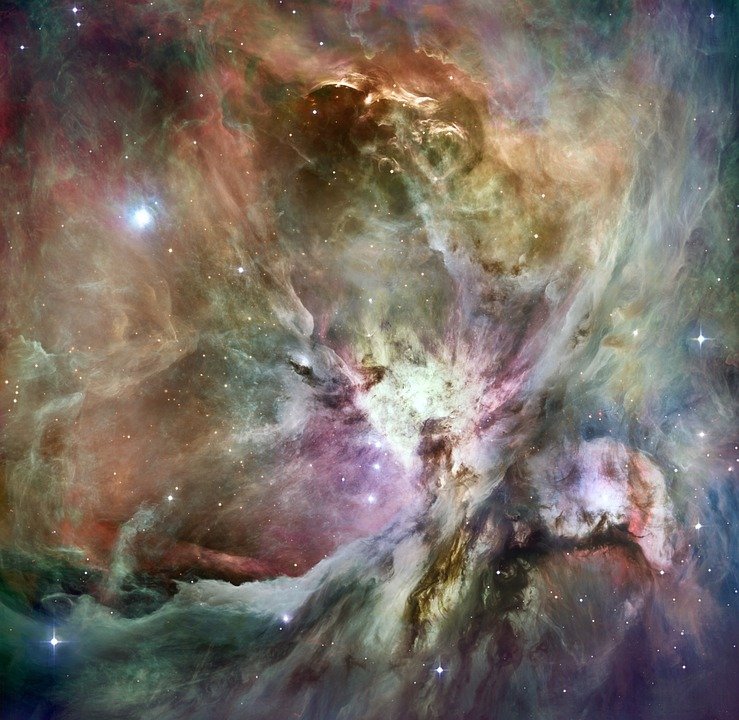
One of the most magnificent shows in the entire galaxy is going on right overhead and most people dont even realize it. Baby stars, already giants, are being born. The florescent interstellar wispy spectres of a long dead behemoth . Rogue stars adrift, racing freely through space on galactic odysseys. A mighty star possibly about to explode so brightly that one day for a short while it will outshine the moon. Binary stars swirling like figure skaters around each other. And perhaps, even possibly a black hole. All found in just one familiar location in the sky most people just absently glanced at.
Just recently I have started teaching my six year old son astronomy. Being on school holidays it was the perfect opportunity to have him stay up a bit past his bedtime to look through the telescope and chart the stars using night sky apps. I'll never forget his face when he first saw the moon through the eyepiece of the telescope. He exclaimed "wow!" Then marched around shouting "moo-,oon!! Moo-oon!!" After a very brief pause in festivities he ran towards the house. I yelled after him "hey where are you going?" To which he responded. "Mummy needs to see this!"
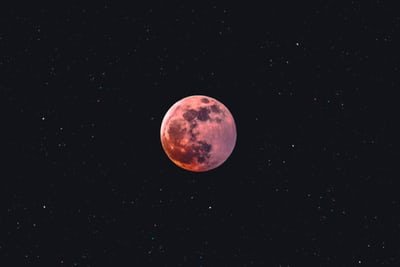
Since then he's had a love for stars and the planets. Which left me a bit of a challenge. How do I keep this streak of wonderment going for the little guy. I stood there at the end of our driveway later that evening pondering what to do when I panned across the heavens and spotted three conspicuous stars lined up in a neat row and raised an eyebrow. "Yeah....thats perfect." I thought to myself. The next night was going to be a lesson on Orion. A constellation that has it all.
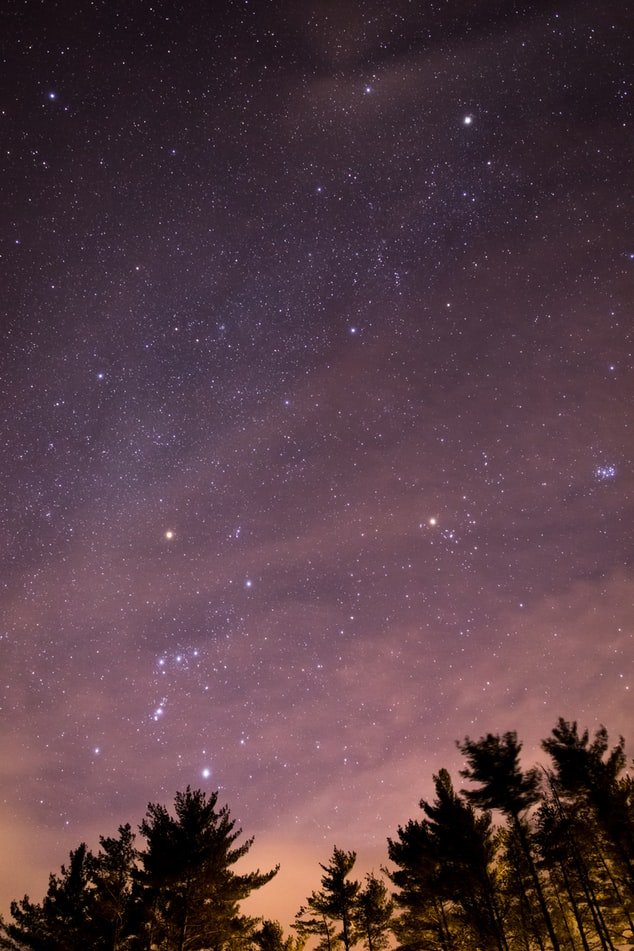
Nearly everyone on earth has looked up at the night sky at one point in their life and noticed the iconic group of stars at least once even if just briefly. Orion has been a part of humanity since prehistory. In West Germany a carving of Orion was found engraved onto mammoth ivory thats dated to be roughly 35,000 years old. Even back then our ancestors stared up into the night with curiosity and awe towards the celestial treasure trove that is Orion. If only they knew like we do now all that Orion is hosting besides simple stars. Allow me to take you on a tour of the spectacular heavenly ensemble including intriguing tidbits most casual viewers would never realise.
The constellation itself resembles an hourglass with a belt of three distinct stars at its center. It is said to form the image of the Greek mythical hunter Orion complete with a club held high as if ready to strike, shield thrusted forward and even a sword sheathed in its scabbard hanging off his side.
Orion hosts several famous stars that are so large that their true size is hard to fathom. Forming the hunters right shoulder (left upper corner of hourglass from the viewers perspective) is a red supergiant thats been in the news recently called Betelgeuse (Alpha Orionis). Burning stoplight red in the night sky Betelgeuse recently has been observed dimming in intensity. Astronomers cant be entirely sure, but they do know this is exactly what Betelgeuse is expected to do just before she expires in a blaze of glory known as a supernova. When she eventually does, she will momentarily for a few weeks shine brighter than the moon in the night sky. As amazing as this occurance will be when it happens it could be anytime between now and the next 100,000 years. Which in universal time spans is basically any moment. Luckily earth will be safe since Betelgeuse is located 624 light years from earth. But the left over gasses and debris will one day form the closest nebula to our home star system complete with a stellar nursery birthing newborn stars inside. The nebula will forever alter the night sky and be a beautiful addition to all of our evening vistas.
The other shoulder is Bellatrix (Gamma Orionis) the "Amazon Star." She is our closest neighbor in the constellation at 244 light years and a blue giant. Shes not big enough to go out in a blaze of glory but being a B-type star she burns very hot.
The brightest star of the bunch is Rigel (Beta Orionis) who forms the left foot of the constellation. Also a B-type blue supergiant shes much older and bigger than her sister. Rigel is a big girl, 70 times wider than our own sun and already nearing the final stages of her life. She may be very bright but shes actually cooling down. In her prime she was three times hotter than she is today. Scientist know her time is up soon they just arent sure which ways shes going to exit the stage. She may also become a supernova like Betelgeuse or collapse into a white dwarf leaving a gaseous shell of her exterior to expand like a cloud outwardly.
Siaph forms the other foot and Meissa (composed of many stars actually, just looks like only one) the head. The three stars of the belt are Mintaka, Alnilam and Alnitak. Mintaka is actually a binary star system. The two stars partners in a dance spinning about the other. The pair complete a rotation once every 5 and a half days. Alnilam the middle one is quickly burning through its fuel and Alnitak is the outer star furthest to the left on the belt. Alnitak saw Mintaka's binary showmanship and said 'hold my beer' deciding to one up his neighbor and became a triple star system, but we'll return to Alnitak later because hes much more than meets the eye.
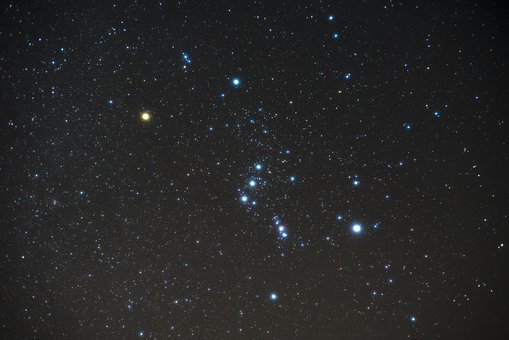
In the eastern sky in general is a massive, humongous ring of barely visible dust slowly expanding that was discovered only recently because its so hard to detect. When I say massive I'm talking 330 light years wide. For scale that would take up the same portion of the sky 27 moons sitting side by side would. And our nearest star is just slightly further than 4 light years away to get anidea of distance. So this thing is really big. This hoop of interstellar dust is thought to be the violent result of a very, very large supernova. On the edge of this ring, at its densest part, a section has coalesced into one of the most beautiful and brightest nebulas in our night sky. Its so close and bright that you can even see it with the naked eye. And this is called The Great Orion nebula or M42.
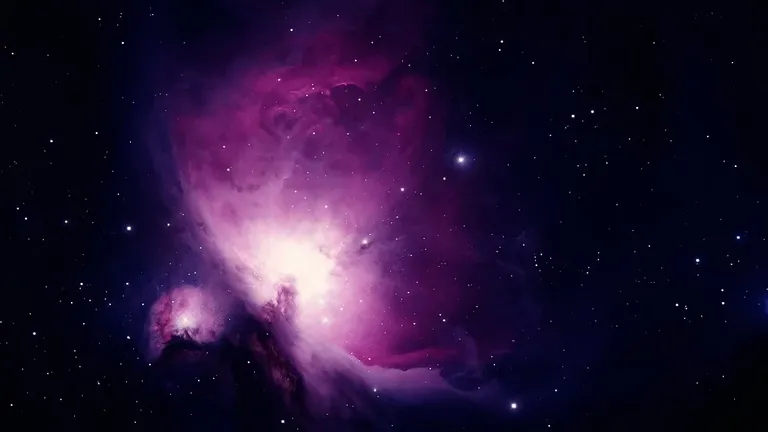 M42 The Great Orion nebula accompanied by the much smaller Mairans nebula M43.
M42 The Great Orion nebula accompanied by the much smaller Mairans nebula M43.
If you look at Orion tonight and search for his sword hanging in between his legs you can see this nebula for yourself. You'll notice a milky whitish blue fuzzy star. That's the nebula shining back at you from 1,500 light years away. As nebulas go its whats called an emission nebula. The bright ultra violet light of the stars within energizing and ionising the stellar dust causing it to glow much in the same way the gasses in a neon light or florescent bulb do.
At the core of the nebula powering its illumination while simultaneously feeding off this dust, is whats called the Trapezium (Theta Orionis). A stellar nursery of 6 baby stars that are mere infants in the scale of things. However don't let baby fool ya, they aren't exactly small. Appearing through a naked eye the Trapezium looks like a single star however under a pair of binoculars or telescope you can begin to see the four main stars that form its trapezoidal shape. Two of which are actually binary star systems.
The Trapezium is something of a mystery though to astronomers as a few strange things have been observed within it. Mainly, some stars in the Trapezium are running amuck. They're racing through space much faster than they should and they're scattering in different directions. It's a phenomenon called runaway stars. And to make things even more wild some of the stars were ejected and hurled out of the star cluster like a shotput while others were slung inwards colliding with one particularly massive star inside that is now suspected ofhaving collapsed down into a small black hole 200 times the mass of our sun. So if you ever want to look into the night sky and see where a black hole is likely to be hiding there you go. Look no further than good old Orion and his sword.
As to why the stars are zinging about. Well scientists have proposed a few theories. One is a supernova blasted the surviving stars outward into space. The other is that in the congested nursery, gravitational attraction drew stars closer together that would in turn then begin to spin around each other. Once spun up and with enough energy the pairs of stars flung apart each in opposite directions.
Immediately adjacent to the Great Orion nebula separated by a black curtain of dark dust is a luminous cloud of resembling a fat comma called De Mairan's Nebula or M43. De Mairan's nebula is so close visually to the Great Orion nebula that most assume the smaller nebula is part of the larger one. However, it is actually another 100 light years further away. De Mairan is interesting because some scientists speculate that the nebula is mainly dense and dark like a coccoon masking the light of the stars inside from the rest of the galaxy. And, that we on earth, are looking into the heart of this coccoon through the end of a open tunnel or canal leading deep inside the nebula.
At the bottom of Orion's sword you'll see its brightest object, the binary star Hatysa or Iota Orionis. What makes Hatysa interesting is that its composed of an ancient and massive O type star (Blue Giant) and a much, mich smaller B type star half it's age. Scientist believe the smaller star was actually captured when it passed to close to the larger stars gravity well. The two rotate around each other and are a very intense source of X rays.
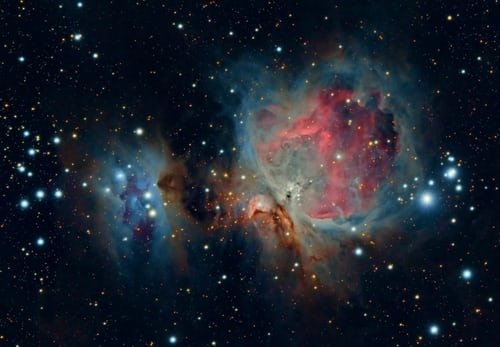 Photo of Hatysa, M42/M43, The Running Man nebula and the star cluster NGC-1981.
Photo of Hatysa, M42/M43, The Running Man nebula and the star cluster NGC-1981.
A short distance above the M42/ M43 pair is a second whimsically named nebula thats often seen in photos of the Great Orion nebula called The Running Man nebula. Its really a combination of three closely packed nebulas called NGC-1973, NGC-1975 and NGC-1977. The cluster as a whole named after NGC-1977. In photos you'll notice its not nearly as bright as the prior two mentioned nebulas and it does indeed resemble a stick figure running not much unlike a crosswalk signal. Running Man may be visible with the naked eye on a very clear night, although the man inside of it will be too faint to distinguish.
If you allow your eye to continue panning up to the hilt of Orion's sword you'll see a cluster of 20 faint stars closely grouped together. This is NGC-1981. Under even a small telescope or binoculars it will look like a spattering of blue sapphires in the night sky. I remember being ignorant of this clusters existance and stumbling across them with my telescope and remarked "what the heck is this!" I had no idea they were up there.
For a truly glorious photo taken by a fellow steemian that captures all of orions sword from NGC-1981 all the way down to Hatysa check out @astrophoto.kevin He just recently took a photo of Orion's nebula that captures all the delicate lacy nuances of the dust cloud. Its also in high definition so you can really have a great look.
±+++++++++++++++++++++++++++++++++++++++++++++++++++++++++++++++++++++++
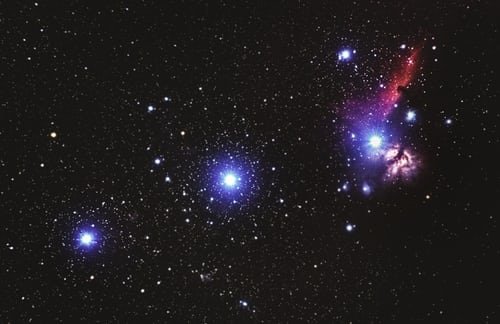 The stars of orions belt. As seen from the southern hemisphere. From left to right. Mintaka, Alnilam and Alnitak. Note the pair of nebula.
The stars of orions belt. As seen from the southern hemisphere. From left to right. Mintaka, Alnilam and Alnitak. Note the pair of nebula.
Now lets return to Alnitak the star I spoke of earlier that makes up the left side of Orion's belt. I said it was much more than meets the eye. With a midsized telescope one can see descending directly from the bright star a softly glowing red pillar of light seemingly being blown gently to one side. Dead center of this nebula is an immediately recognizable black silohuette resembling a knight chess piece. This is the Horsehead nebula. IC-434. Also known as Bernard 33 after one of the first guys to describe it. The horse shape is caused by dark interstellar dust.
 The Horsehead nubula and Flame nebula with Alnitak in the center.
The Horsehead nubula and Flame nebula with Alnitak in the center.
A close neighbor to the Horsehead nebula immediately to the left of Alnitak is the gorgeous Flame nebula. NGC-2024. This stunning juxtposition of dark dust and lacy glowing veins resembles pastel stained quilted maple. At the heart of the Flame nebula are several juvenile stars many seen with circumstellar discs forming. Which means planets are busy forming around these stars.
Because Alnitak is so bright, its light floods space and washes out most of the view of both the Horsehead nebula and the Flame nebula. But a powerful enough telescope will be able to see glimpses of both on particularly clear and dark nights.
The Orion constellation still has a few more secrets to reveal to budding space enthusiasts. A modest distance above Alnitak is the lesser know but still spectacular nebula known simply as Messier 78 or M78. Named after the famous french astronomer Charles Messier who took the time to catalogue many of these deep space objects in the 1700s. Just in case you were wondering what all the M this M that business was all about. M78 is visible with most telescopes and is a good choice after viewing M42 and M43.
One intriguing feature that spans across Orion is Bernard's Loop a faint red tendril that arcs across the left side of the constellation encompassing everything from M78 on top to M42 on the bottom.
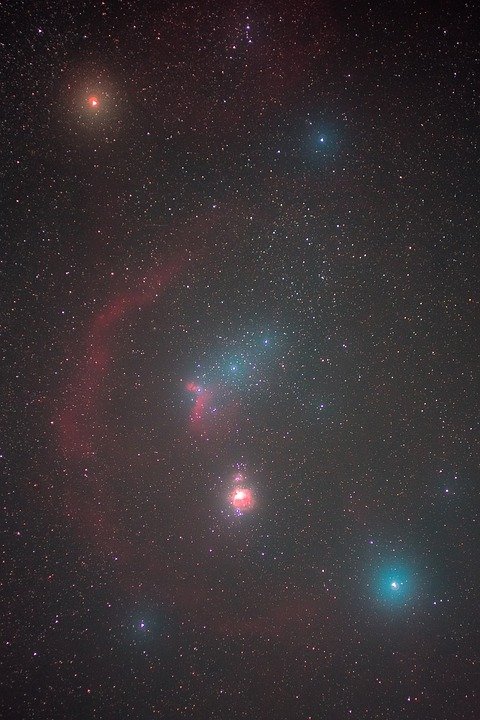 The Bernard Loop starting in between Betelgeuse and Orion's Belt. The nebula M78 is this general area at the top of the loop. The nebula then arcs down past Alnitak and its two nebulas past orions sword, passing close to Siaph before terminating just before Rigel.
The Bernard Loop starting in between Betelgeuse and Orion's Belt. The nebula M78 is this general area at the top of the loop. The nebula then arcs down past Alnitak and its two nebulas past orions sword, passing close to Siaph before terminating just before Rigel.
A note worthy member of Orion's unbelievably rich collection of celestial objects is the Angelfish nebula. Which engulfs Meissa and Orion's head. It literally looks like an angelfish and its massive in size. Its very faint though.
As you can see Orion is a bountiful place and worthy of a second look and more than just a casual glance. Next time you're out and catch sight of the Orion constellation maybe you'll see it with new found appreciation. As for my son, I'm hoping that he will take the lessons of studying Orion and keep them as a lifelong companion. One day, later in his life, once I'm gone and have passed into the great beyond he can still look up at the night sky, see Orion and have a connection to his dad that he can keep forever. Maybe even pass it on to his own son.
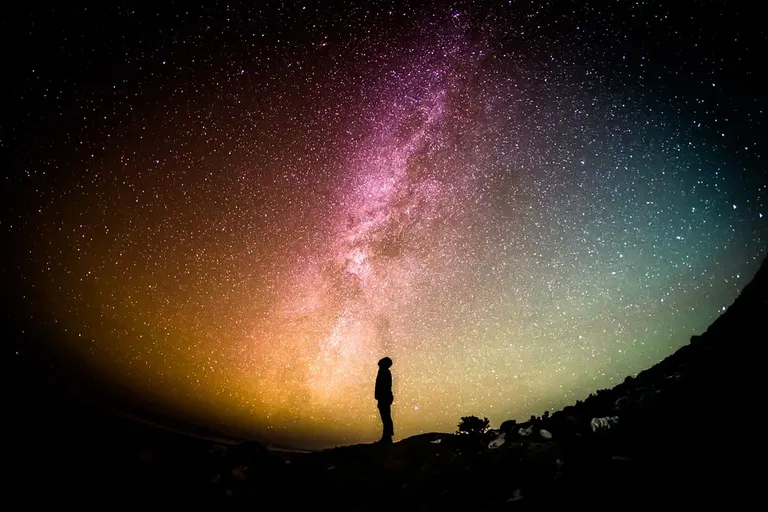
++++++++++++++++++++++++++++++++++++++++++++++++++++++++++++++++++++++++++
I hope you enjoyed this little tour around the famous constellation of Orion. Next time I will be focusing on the southern skys of Australia that host the Magellenic Clouds and the Carina nebula among other jewels.
All images provided by Pixabay and Unsplash.
I would have liked to include many other interesting photos such as that of the Trapezium and M78, however this was what I could find on Pixabay and Unsplash. I highly encourage the reader to google images of the many nebulas presented here as there are much finer images that can be seen in a cursory search.
To listen to the audio version of this article click on the play image.

Brought to you by @tts. If you find it useful please consider upvoting this reply.
Hi steemydave,
Visit curiesteem.com or join the Curie Discord community to learn more.
Thank you curie!!!
Its always an honor to get curied and i am definitely appreciative.
Thanks again
halo @steemydave, this is an amazing post !! I love our starry ceiling, when I can I relax in the night and look up, I always feel overwhelmed by so much immensity and so small in the world !! everything you have told is amazing, i am sure your child will be very happy and will keep these moments with you forever;)) all the best for you
Hey road2horizon!! I'm happy you liked the post. I, like you, feel in awe about just how vast the universe us and enjoy staring up into the night sky in wonder. Somehow, for me, the immensity of space feels comforting. I like to think it's reassuring that theres so much bounty around us in this universe.
As for the little guy hes going to have to wait a few days before he gets more telescope time. It looks like we're finally going to get some rain in our little outback town the next few days! But when it clears up I think I'll set the plieadies in his sights. Its close by to orion and in an easy spot in the sky for us to view right now.
Thank you again for your comments!
Congratulations @steemydave! You have completed the following achievement on the Steem blockchain and have been rewarded with new badge(s) :
You can view your badges on your Steem Board and compare to others on the Steem Ranking
If you no longer want to receive notifications, reply to this comment with the word
STOPVote for @Steemitboard as a witness to get one more award and increased upvotes!
This post is simply wonderful. Astronomy, family and a story told in spectacular way. You should think about writing science fiction stories for kids! I have learned a lot today. Thank you for this beautiful post and congratulations on the Curie vote. Regards @steemydave
Hi Marcy! Thank you for the kind comment. I've actually thought about writing childrens scifi before. I'm seriously considering it. I read to my son most nights and I often get ideas for a childrens space adventure where its also educational.
10/10 for that impulse of creative writing!
I just recently edited my blog to make an addition. But I'd like to mention it here too. For a wonderful high definition shot of Orion's sword focusing on M42 take a look at steem member @astrophoto.kevin and the shot he just recently took. Its beautiful.
According to the Bible, What is the danger of not spreading the Gospel of Christ worldwide as you do today? (Part 2 of 3)
Comment what you understand of our Youtube Video to receive our full votes. We have 30,000 #SteemPower. It's our little way to Thank you, our beloved friend.
Check our Discord Chat
Join our Official Community: https://beta.steemit.com/trending/hive-182074
A really awesome and impressive read @steemydave
A wonderful story about the constellation Orion and its jewels.
I'm pretty sure that your son will keep this lesson and everyone that will follow. Even if they got in the background while growing up, they will be back if he is when he is an adult.
Thanks Kevin! I figure that as he grows up he'll go through stages of interest in various things. He gravitates towards STEM subjects and general outdoors play. He also likes gardening and especially math. But its my hope that with father son bonding while learning these things he'll find comfort in returning to them often throughout his adult life. And in my opinion astronomy is going to have a spectacular next few decades of tremendous discovery. Giving him ample opportunities to be reminded of our stargazing and lessons together.
I look forward to your next post and what you'll photograph next.
You're welcome :-)
This father-son bonding will for sure give him a lot of comforts, what path he may ever choose :-)
I think the next post will be about the Rosette Nebula, but I still have to edit the image and make the text for it.
Rosette nebula will be a good one to see. I hope you can capture is beautiful rich red hue. I'll be on the lookout for it.
As for me I'm in the middle of writing post doing a visual tour around Carinae and all thats inside of that nebula.
I already have 8 of 10 hours of the images captured. But I think, won't be able to get the remaining 2 hours because of the weather.
I'm very curious about your Carinae post :-)
For images, I think Dylan O'Donnell should have some really nice ones, that are also public domain.
http://deography.com/category/astrophotography/
Thank you so much for the link to Dylan's webpage. I found 3 exquisite photos i plan on using thanks to your advice. Finding cc0 images i can use for these posts has been a daunting task. I spent several hours yesterday on pixabay and other similar sights only to come away with a handful of images i could use. Youd think something as spectacular as the Homunculus nebula would have a few images floating around but I found one lone image after three hours of scouring the internets public domain photo sites. So I greatly thank you!
You're welcome :-)
Finding pictures can sometimes be a really hard work.
For astro pictures you can also check out https://www.astrobin.com/
Some of the images there are under CC licence that allow even commercial usage.
Hey! Sorry about the late reply. I found some images on astropin that I can use for my next post after Carina which will be focusing on the Magellenic Clouds and other dwarf galaxies close to the Milky Way and how they have contributed to its current form. The Carina post will be up this Monday. (Tomorrow) It's much larger of a post than the Orion one as there was so much to cover. And its full of photos I was eventually able to find.
Thank you again for your help.